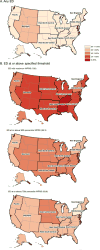Access to High Pediatric-Readiness Emergency Care in the United States
- PMID: 29336799
- PMCID: PMC5826844
- DOI: 10.1016/j.jpeds.2017.10.074
Access to High Pediatric-Readiness Emergency Care in the United States
Abstract
Objective: To determine the geographic accessibility of emergency departments (EDs) with high pediatric readiness by assessing the percentage of US children living within a 30-minute drive time of an ED with high pediatric readiness, as defined by collaboratively developed published guidelines.
Study design: In this cross-sectional analysis, we examined geographic access to an ED with high pediatric readiness among US children. Pediatric readiness was assessed using the weighted pediatric readiness score (WPRS) of US hospitals based on the 2013 National Pediatric Readiness Project (NPRP) survey. A WPRS of 100 indicates that the ED meets the essential guidelines for pediatric readiness. Using estimated drive time from ZIP code centroids, we determined the proportions of US children living within a 30-minute drive time of an ED with a WPRS of 100 (maximum), 94.3 (90th percentile), and 83.6 (75th percentile).
Results: Although 93.7% of children could travel to any ED within 30 minutes, only 33.7% of children could travel to an ED with a WPRS of 100, 55.3% could travel to an ED with a WPRS at or above the 90th percentile, and 70.2% could travel to an ED with a WPRS at or above the 75th percentile. Among children within a 30-minute drive of an ED with the maximum WPRS, 90.9% lived closer to at least 1 alternative ED with a WPRS below the maximum. Access varied across census divisions, ranging from 14.9% of children in the East South Center to 56.2% in the Mid-Atlantic for EDs scoring a maximum WPRS.
Conclusion: A significant proportion of US children do not have timely access to EDs with high pediatric readiness.
Keywords: access; emergency department; geographic access; pediatric-ready.
Copyright © 2017 Elsevier Inc. All rights reserved.
Conflict of interest statement
The authors declare no conflicts of interest.
Figures

Comment in
-
Not all emergency departments are alike.J Pediatr. 2018 Mar;194:2-3. doi: 10.1016/j.jpeds.2018.01.005. J Pediatr. 2018. PMID: 29478498 No abstract available.
References
-
- American Academy of Pediatrics Committee on Pediatric Emergency M. Yamamoto LG. Access to optimal emergency care for children. Pediatrics. 2007;119(1):161–4. - PubMed
-
- American Academy of Pediatrics Committee on Pediatric Emergency Medicine, American College of Emergency Physicians Pediatric Committee, Emergency Nurses Association Pediatric Committee. Joint policy statement–guidelines for care of children in the emergency department. Ann Emerg Med. 2009;54(4):543–52. - PubMed
-
- American Academy of Pediatrics, Committee on Pediatric Emergency Medicine, American College of Emergency Physicians Pediatric Committee, Emergency Nurses Association Pediatric Committee. Joint policy statement–guidelines for care of children in the emergency department. Pediatrics. 2009;124(4):1233–43. - PubMed
-
- Gausche-Hill M, Schmitz C, Lewis RJ. Pediatric preparedness of US emergency departments: a 2003 survey. Pediatrics. 2007;120(6):1229–37. - PubMed
-
- Schappert SM, Bhuiya F. Availability of pediatric services and equipment in emergency departments: United States, 2006. Natl Health Stat Report. 2012(47):1–21. - PubMed
Publication types
MeSH terms
Grants and funding
LinkOut - more resources
Full Text Sources
Other Literature Sources

